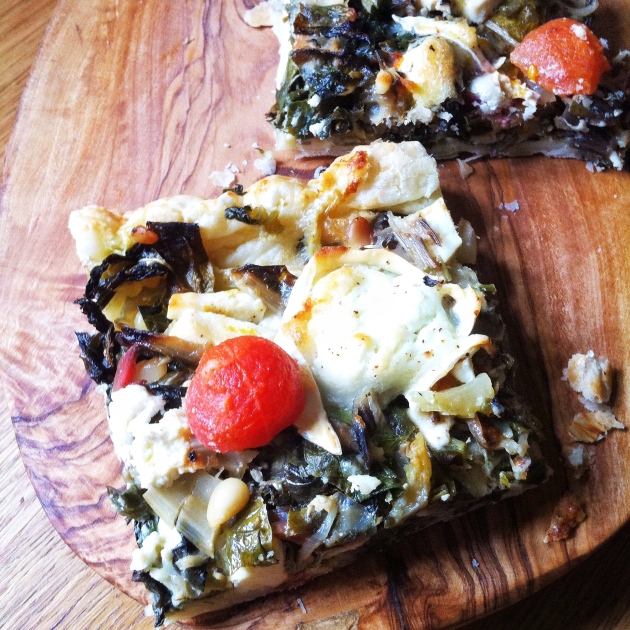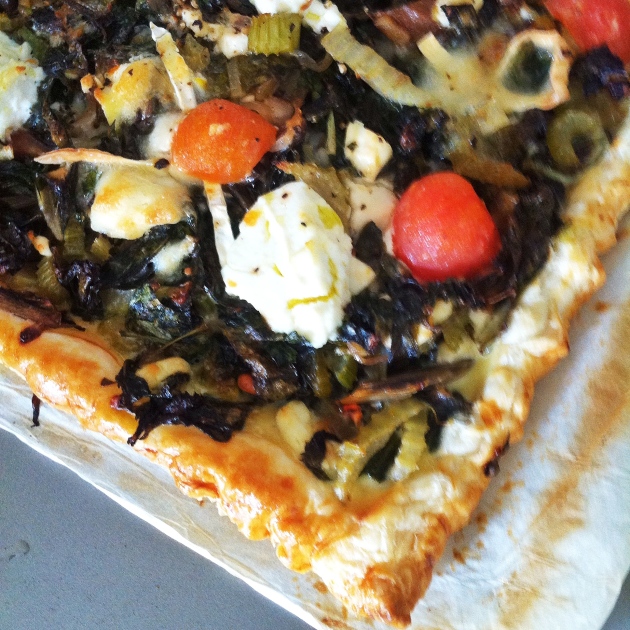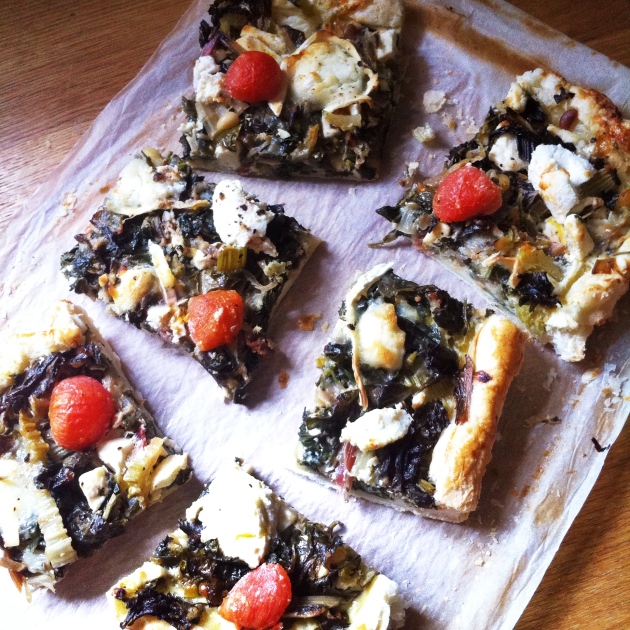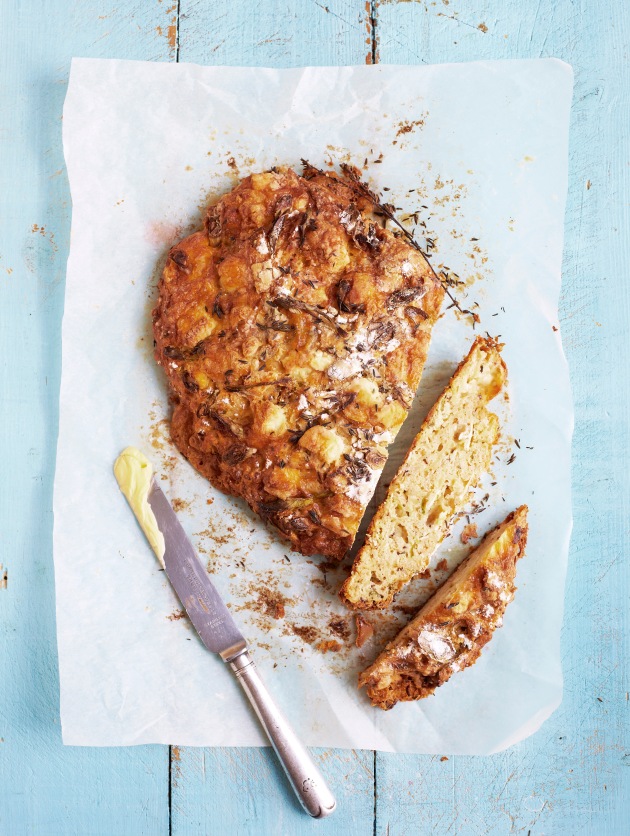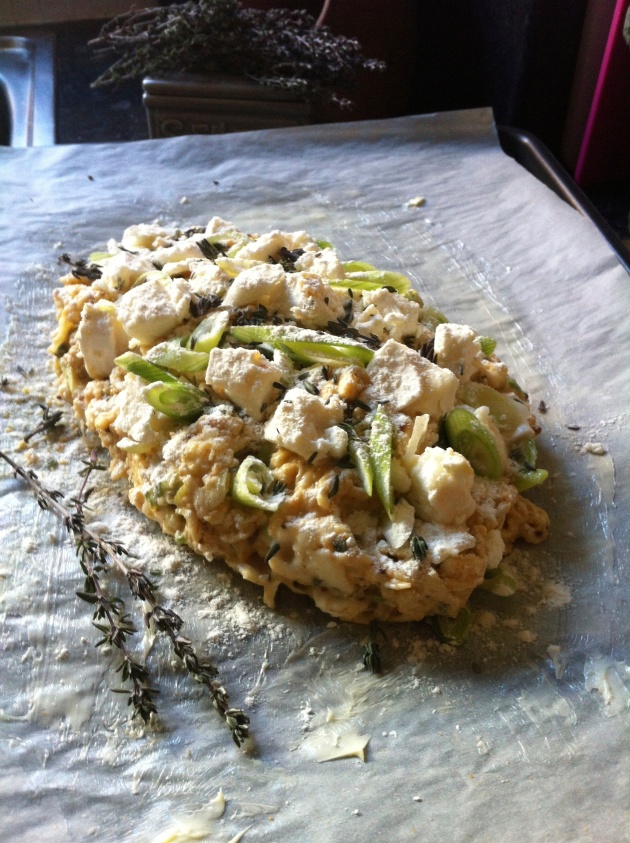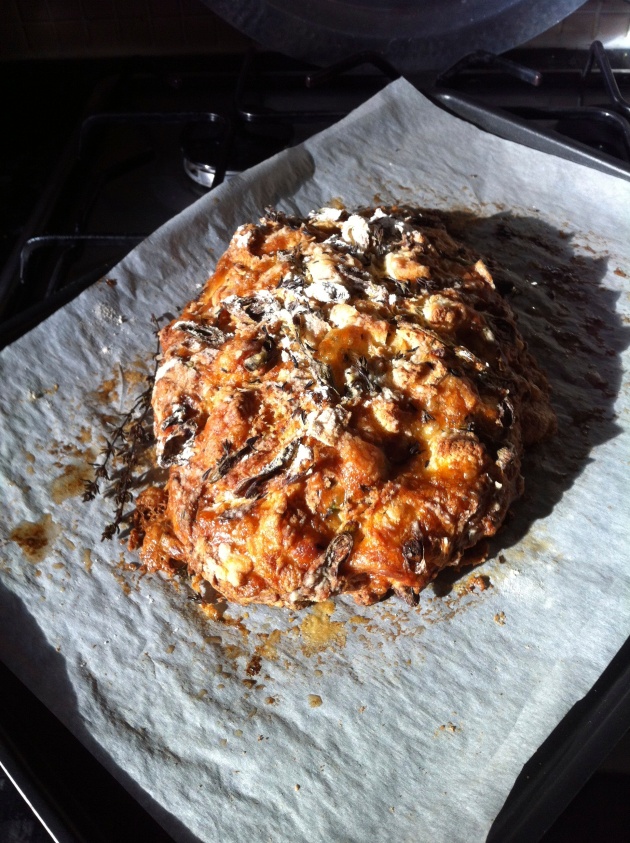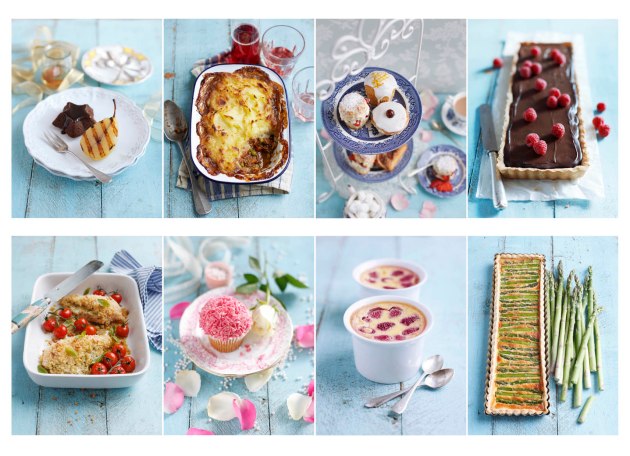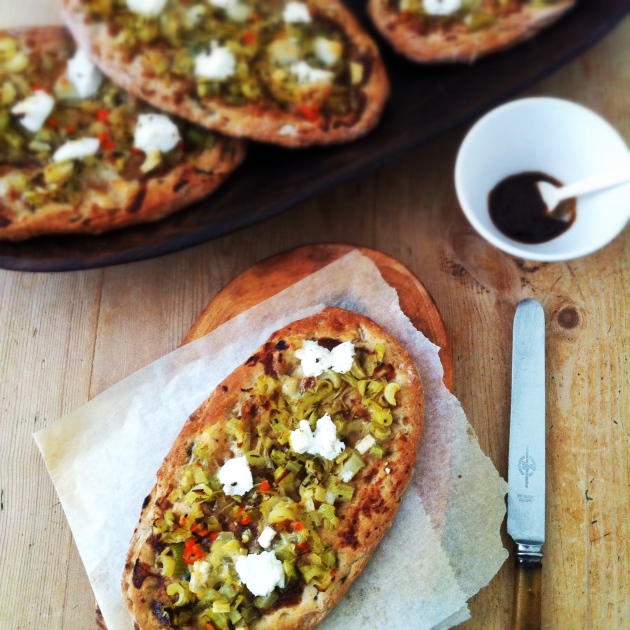 It’s funny how inspiration strikes. Aware that the clock was counting down fast on the deadline for submitting a ‘yeast and herb’ based post for Angie’s first Fiesta Friday Challenge, I found myself dithering over recipes, like a debutante in a dress shop. I cursorily glanced through some of my bread baking books but nothing appealed. I googled “yeast recipes”; still nothing appealed. In the meantime, fabulous dishes were being submitted; Sue with her fabulous fermented kvas as a base for a Russian soup, Michelle with her luscious peach and basil danishes; Angie herself posted a stunning looking Fougasse…tick, tock, tick tock… Oh, what to do? I pop into my local green grocers to pick up some tomatoes and basil for a salad. Checking my purse, there isn’t enough change to cover it so I pull out my card to pay then realise that there is minimum £5 purchase for card transactions. I had been eyeing up a tray of squidgy Mejool dates, so I added them to the basket as Jake loves them. The next day, I wander into the kitchen to make a coffee, idly thinking about the day ahead when my eyes fall on the dates. I think about flavour combinations and imagine that dates and goats’s cheese would work. A quick internet search shows that I am not alone in thinking this. Progress! I plump for a seeded flatbread by bread maestro, Dan Lepard, to which I will add thyme, make tamarind and date sauce and a topping of leeks & celery. I have a moment’s worry as to this flavour combination, so try a teaspoonful of the leek and celery, topped with a cube of goat’s cheese with a dribble of the date and tamarind sauce. Hurrah!! It is delicious! Sharp, tart, grassy, crunchy, earthy, lemony, spicy – it works!! I will go to the ball, I will!
It’s funny how inspiration strikes. Aware that the clock was counting down fast on the deadline for submitting a ‘yeast and herb’ based post for Angie’s first Fiesta Friday Challenge, I found myself dithering over recipes, like a debutante in a dress shop. I cursorily glanced through some of my bread baking books but nothing appealed. I googled “yeast recipes”; still nothing appealed. In the meantime, fabulous dishes were being submitted; Sue with her fabulous fermented kvas as a base for a Russian soup, Michelle with her luscious peach and basil danishes; Angie herself posted a stunning looking Fougasse…tick, tock, tick tock… Oh, what to do? I pop into my local green grocers to pick up some tomatoes and basil for a salad. Checking my purse, there isn’t enough change to cover it so I pull out my card to pay then realise that there is minimum £5 purchase for card transactions. I had been eyeing up a tray of squidgy Mejool dates, so I added them to the basket as Jake loves them. The next day, I wander into the kitchen to make a coffee, idly thinking about the day ahead when my eyes fall on the dates. I think about flavour combinations and imagine that dates and goats’s cheese would work. A quick internet search shows that I am not alone in thinking this. Progress! I plump for a seeded flatbread by bread maestro, Dan Lepard, to which I will add thyme, make tamarind and date sauce and a topping of leeks & celery. I have a moment’s worry as to this flavour combination, so try a teaspoonful of the leek and celery, topped with a cube of goat’s cheese with a dribble of the date and tamarind sauce. Hurrah!! It is delicious! Sharp, tart, grassy, crunchy, earthy, lemony, spicy – it works!! I will go to the ball, I will! 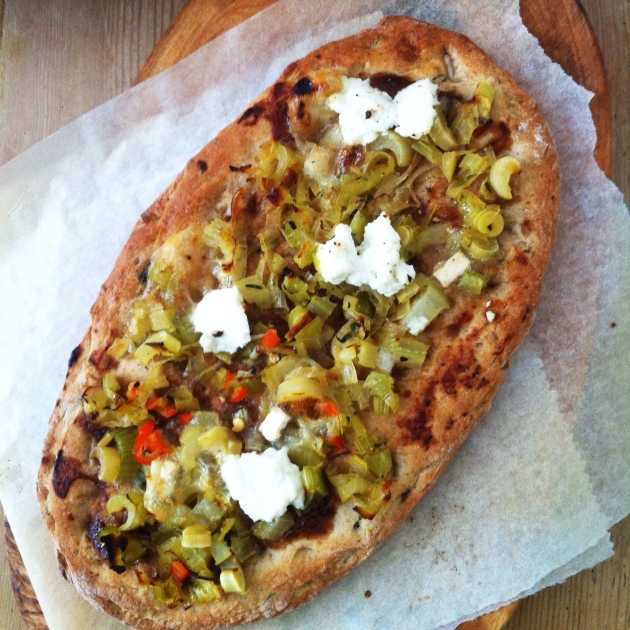
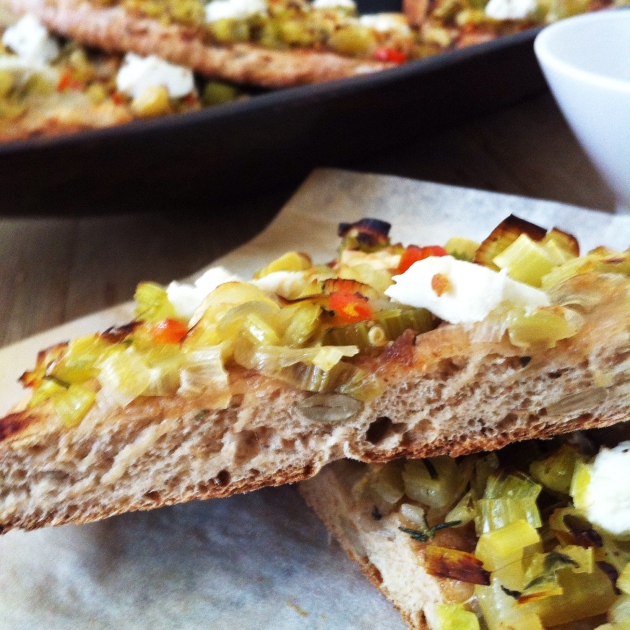 Once baked, the goat’s cheese has melted and the creamy ricotta is a wonderful counterpoint to the heat from the chilli flakes and the crunch of the seeds. Next time I will add more ricotta (I’ve updated the recipe below to account for this). Angie is being very ably assisted by Catherine @ Catherine Cuisine. Please do go and look at the entries for this yeast and herb based challenge; you will find crumpets, semolina pancakes, pizzas, flat breads and much, much more – the Creative Fiesta Friday Crew are rising beautifully (see what I did there, Angie and Catherine?) to the challenge! So this is how to make some easy and delicious Turkish inspired Pides – feel free to use different toppings but I have to say that I was really pleased with the combination below. As always, a printable recipe follows the photo tutorials and any musings.
Once baked, the goat’s cheese has melted and the creamy ricotta is a wonderful counterpoint to the heat from the chilli flakes and the crunch of the seeds. Next time I will add more ricotta (I’ve updated the recipe below to account for this). Angie is being very ably assisted by Catherine @ Catherine Cuisine. Please do go and look at the entries for this yeast and herb based challenge; you will find crumpets, semolina pancakes, pizzas, flat breads and much, much more – the Creative Fiesta Friday Crew are rising beautifully (see what I did there, Angie and Catherine?) to the challenge! So this is how to make some easy and delicious Turkish inspired Pides – feel free to use different toppings but I have to say that I was really pleased with the combination below. As always, a printable recipe follows the photo tutorials and any musings.  Ever since I attended Nina Oortman’s bread making class, I have been coveting the stainless steel counters that make bread kneading, shaping and clean up so effortless. I came across this rather large stainless steel serving/prep tray from my catering days, while I was unpacking and had a Eureka! moment. Rather than bestowing the tray on my local charity shop, it could come in useful for pasta and dough making – and it has, as you will note from the photos below…
Ever since I attended Nina Oortman’s bread making class, I have been coveting the stainless steel counters that make bread kneading, shaping and clean up so effortless. I came across this rather large stainless steel serving/prep tray from my catering days, while I was unpacking and had a Eureka! moment. Rather than bestowing the tray on my local charity shop, it could come in useful for pasta and dough making – and it has, as you will note from the photos below… 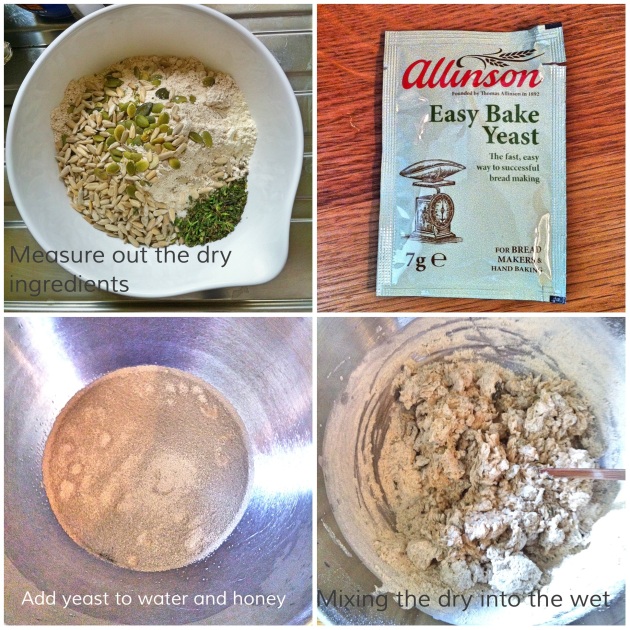 I used a chopstick to roughly mix the dry ingredients into the wet, thanks to a tip from Aneela @ The Odd Pantry and it worked brilliantly. No more sticky dough adhering plaster-like to each finger! The dough is sticky – resist the temptation to add lots of flour when you are working with it. This dough does not require very much handling – hardly any kneading in fact. A light hand and as little additional flour as possible will yield a more tender bread.
I used a chopstick to roughly mix the dry ingredients into the wet, thanks to a tip from Aneela @ The Odd Pantry and it worked brilliantly. No more sticky dough adhering plaster-like to each finger! The dough is sticky – resist the temptation to add lots of flour when you are working with it. This dough does not require very much handling – hardly any kneading in fact. A light hand and as little additional flour as possible will yield a more tender bread. 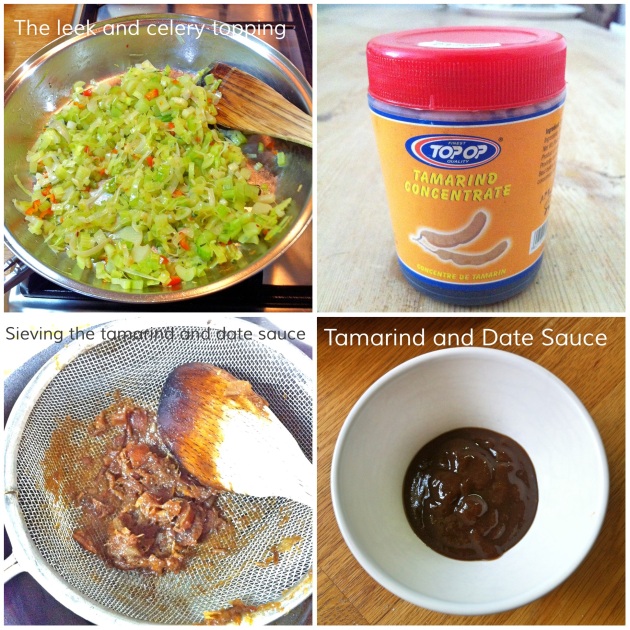

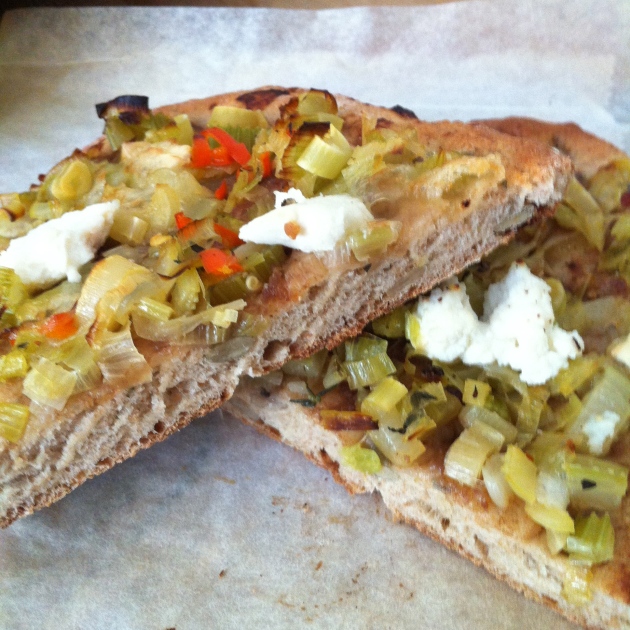
Thyme and Seed Pide with a Leek, Celery and Goat's Cheese Topping
- 175 g all plain flour
- 75 g spelt flour (or wholemeal)
- 25 g sunflower seeds
- 25 g pumpkin seeds
- 1 Tbsp chopped thyme leaves (fresh)
- 1 tsp fine salt
- 175 g warm water (this is the same as 175 ml in volume. Weighing the water is a more accurate measure)
- 25 g honey
- 7 g sachet fast acting yeast
For the leek and celery topping:
- 1 Tbsp olive oil
- 100 g diced celery (3 stalks)
- 2 shallots finely sliced
- 140 g finely sliced leeks
- water as required
- 1 mini sweet red pepper finely diced
- pinch of chilli flakes
- 1 tsp finely chopped thyme leaves (fresh)
- 60 g cubed or crumbled goat’s cheese
- 12 tsp ricotta cheese
- salt and pepper
For the tamarind and date sauce:
- 10 soft pitted dates roughly chopped – soak them if they are dry
- 1 ½ tsp tamarind concentrate
- 100 ml water
INSTRUCTIONS For the pide:
- Measure out all the dry ingredients (not the yeast though) into a mixing bowl and stir well to combine.
- Measure the honey and warm water directly into a mixing bowl set on the scales and mix well to combine
- Sprinkle over the yeast and stir in.
- Add the dry ingredients and mix until it is a soft, shaggy, sticky dough (I used a chopstick to stir it round and round ).
- Cover and let this rest for 10 minutes.
- Lightly flour a work surface and very lightly knead the dough for about 10 seconds! It comes together very quickly.
- Place back in the bowl, cover and leave to prove for 30 minutes.
For the leek and celery topping:
- Heat the olive oil in a frying pain set on a medium low flame.
- Add the celery and shallots and sauté gently for 5 minutes to soften a little. Season with a good pinch of salt.
- Stir in the leeks. If there isn’t enough oil, add a splash of water to get things going – you may need to do this several times. Cook until floppy then stir in the thyme and red pepper and chilli flakes. Cook for a couple of more minutes, season to taste then take off the heat and leave to cool.
For the tamarind and date sauce:
- Place the dates and tamarin in a saucepan set over a medium low flame. Add the water in splashes, stirring with a wooden spoon to dissolve the tamarind – mash the dates with the back of the spoon too. Let this reduce to a thick lumpy sauce (mashing and stirring all the while) and take off the heat.
- Scrape into a wire mesh strainer and set it back over the saucepan. Using the wooden spoon, stir and press the mixture through the sieve until you are left with just the date fibre in the sieve. Scrape the sauce from the bottom of the sieve and into the pan.
To assemble and bake the pide:
- Pre-heat the oven to 240C/465F. Prepare 2 baking trays with parchment or silicone paper or dust with flour.
- Cut the dough into quarters (I weighed the dough, then divided it by four and tried to get 4 balls fairly equal in weight)
- Shape into balls by cupping and pushing the dough to stretch it out and get a smooth top.
- Cover and leave for 5 minutes.
- On a lightly floured surface, roll out each ball into an oval that is about 20 cm x 10 cm. Push at the edges to make a slight lip and lay on the prepared baking sheets.
- Spread a 1 ½ teaspoons of the tamarind date sauce on the dough, leaving the edges free.
- Top each pide with ¼ of the leek and celery mixture.
- Top this with the goat’s cheese and little blobs of ricotta.
- Bake for 10 – 15 minutes. Mine were ready in 10 minutes.
- Eat warm!


